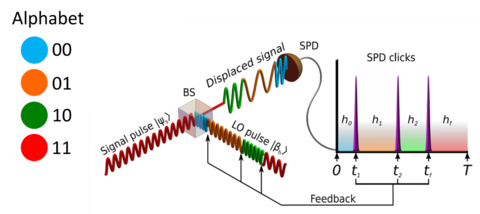Making quantum measurement useful: Quantum State Discrimination beyond classical limits
Summary
Using single-photon detection and an adaptive measurement strategy, we determine the state of an optical pulse with errors below what is possible with even the best possible classical receiver, a limit often referred to as the "standard quantum limit (SQL)" or "shot-noise limit (SNL)."
Description
Quantum receivers are one of the outstanding examples of useful quantum measurements, i.e., the measurements that yield the accuracy beyond the classically accessible means in a practical setting.

In digital optical communications a set of coherent pulses of faint light in any of M previously defined states forms a communication alphabet, where each symbol encodes log2M bits of information. Various sets of states or modulation protocols and corresponding measurement methods are well known in classical digital communications. Here we develop practical quantum-enabled methods and new alphabets that allow us to distinguish such “letters”, but better than any classical measurement can do.
Quantum receivers with legacy modulation schemes
We have developed quantum measurement that allows discrimination of 4 coherent states encoded with different phases (Quadrature Phase-Shift Keying (QPSK) communication alphabet) beyond the classical SQL limit. We have achieved unconditional advantage over an ideal classical measurement of more than 6 dB, and more than 13 dB in comparison to the classical measurement with the same system efficiency. This is the first demonstration of unconditional advantage of quantum measurement for discrimination of more than two states.

The time resolving quantum receiver and the novel modulation schemes
Further, we investigate modulation schemes that can improve “quantum advantage” of a quantum measurement. We have developed and experimentally implemented a new quantum-enhanced communication system that features both the adaptive quantum measurement beyond the classical limit and the novel, “most suitable” modulation protocol numerically optimized to minimize discrimination error probability of the quantum receiver.
We experimentally “unlock” the unforeseen advantages of the quantum measurement enabled by the first modulation scheme specifically designed and optimized for the time-resolved feedback receiver. We achieve record energy sensitivities and demonstrate successful discrimination of large alphabets of optical states (4≤M≤16) beyond the ideal classical shot-noise limit. Thus, we demonstrate the scalability of quantum measurement-enabled communication for the first time.

Shot-by-shot estimation of quantum measurement confidence
The probabilistic nature of quantum measurement outcomes results in inconclusive and sometimes misleading results. Generally, because quantum measurements are probabilistic, prior experimental and most theoretical efforts describe ensemble probabilities for experimental outcomes, not what will occur in each measurement. Yet, specifically because most quantum measurements are probabilistic, the assessment of individual measurements has important implications. Thus, such quantum measurements can provide both the result and the “accuracy” of that result, i.e., shot by shot accuracy. Here we investigate this unique property of the quantum measurement applied to a state identification problem.
We, for the first time, experimentally obtain confidence levels for individual quantum measurements. To do so, we built a quantum-enabled communication link that can send and receive arbitrary user-defined data, also for the first time. In our experiment, the quantum measurement outperforms the idealized classical measurement in several aspects. First, the overall error rate of the quantum measurement is lower. Second, we identify states with higher single-shot certainty (fidelity) more often. Third, our ensemble-averaged certainty (fidelity) turns out to be higher.

The confidence estimation generalizes the quantum state identification problem and enhances the sensitivity and the specificity of the measurement at the same time, beyond classical means. It can be used in many applications where faint light is characterized. Particularly for low-energy telecommunication, the shot-by-shot confidence information can be directly fed into error-correcting algorithms.
Major Accomplishments
Quantum receiver for large alphabet communication, IA Burenkov, OV Tikhonova, SV Polyakov, Optica 5 (3), 227-232 (2018)
Time-resolving quantum measurement enables energy-efficient, large-alphabet communication, IA Burenkov, MV Jabir, A Battou, SV Polyakov, PRX Quantum 1 (1), 010308 (2020)
Boosting Fiber Optics Communications with Advanced Quantum-Enhanced Receiver, AIP Press Release, (2021)
Phys. Rev. Lett. 128, 040404 (2022) - Experimental Shot-by-Shot Estimation of Quantum Measurement Confidence (aps.org)
New Telecom Receiver System Checks Reliability of Message Components in Real Time (2022)


